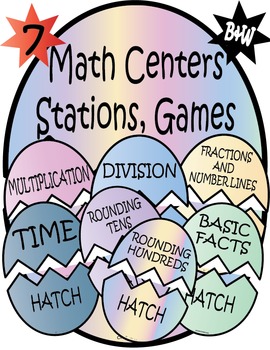3rd Grade Math Centers - Easter Math Activity
Corinne Orozco
93 Followers
Corinne Orozco
93 Followers
Description
7 Easter Egg Math Centers (120 pages), Stations, or Fun-Learning Games!
Both PNG and JPG formats!
1."Hatching-Math Matching" Multiplication -36 pieces, Color or B&W
2."Hatching-Math Matching" Division-36 pieces, Color or B&W
3."Hatching-Math Matching" Time-144 pieces, Color orB&W
4."Hatching-Math Matching" Rounding to 10s-36 pieces, Color or B&W
5."Hatching-Math Matching" Rounding to 100s-36 pieces,Color or B&W
6."Hatching-Math Matching" Basic Facts-36 pieces, Color or B&W
7."Hatching-Math Matching" Fractions and Number Lines-54 pieces, Color or B&W
Positive Feedback welcome! If you would like to see more math centers of these types please inbox me with your specifics! Thank you!
Both PNG and JPG formats!
1."Hatching-Math Matching" Multiplication -36 pieces, Color or B&W
2."Hatching-Math Matching" Division-36 pieces, Color or B&W
3."Hatching-Math Matching" Time-144 pieces, Color orB&W
4."Hatching-Math Matching" Rounding to 10s-36 pieces, Color or B&W
5."Hatching-Math Matching" Rounding to 100s-36 pieces,Color or B&W
6."Hatching-Math Matching" Basic Facts-36 pieces, Color or B&W
7."Hatching-Math Matching" Fractions and Number Lines-54 pieces, Color or B&W
Positive Feedback welcome! If you would like to see more math centers of these types please inbox me with your specifics! Thank you!
Total Pages
120 pages
Answer Key
Included
Teaching Duration
N/A
Report this resource to TPT
Reported resources will be reviewed by our team. Report this resource to let us know if this resource violates TPT’s content guidelines.
Standards
to see state-specific standards (only available in the US).
CCSS3.MD.A.1
Tell and write time to the nearest minute and measure time intervals in minutes. Solve word problems involving addition and subtraction of time intervals in minutes, e.g., by representing the problem on a number line diagram.
CCSS3.NBT.A.1
Use place value understanding to round whole numbers to the nearest 10 or 100.
CCSS3.NBT.A.3
Multiply one-digit whole numbers by multiples of 10 in the range 10–90 (e.g., 9 × 80, 5 × 60) using strategies based on place value and properties of operations.
CCSS3.OA.A.1
Interpret products of whole numbers, e.g., interpret 5 × 7 as the total number of objects in 5 groups of 7 objects each. For example, describe a context in which a total number of objects can be expressed as 5 × 7.
CCSS3.OA.A.2
Interpret whole-number quotients of whole numbers, e.g., interpret 56 ÷ 8 as the number of objects in each share when 56 objects are partitioned equally into 8 shares, or as a number of shares when 56 objects are partitioned into equal shares of 8 objects each. For example, describe a context in which a number of shares or a number of groups can be expressed as 56 ÷ 8.


